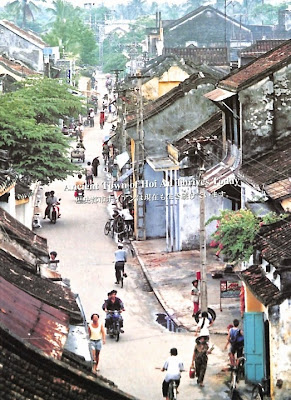Look up the map of Thu Bon River Estuary. Today, the river mouth is clogged with sediment now, but 400 years ago, large boats could easily sail and be towed upstream and dock for unloading and loading along the river town Fafo (Hoi An), trading port for the Chinese, Japanese, Portuguese and Dutch. Most astounding is we can see a well-preserved example of a Southeast Asian trading port circa 15th to 19th Century with buildings that display a unique blend of local and foreign influences that survived the disastrous Vietnam War.
An introductory book on Hoi An I purchased there was surprisingly published by Showa Women's University in Tokyo. I lived close to that university during my Tokyo days. The book said that Showa Women University compiled the catalog in English and Japanese to commemorate the opening of the World Heritage Hoi An Exhibition in 2000 as well as the 80th Anniversary of the University. Proceeds from the sale of the book were donated to the Hoi An People's Committee & Association of Hoi An Cultural/Agricultural Heritage. What a coincidence and beautiful story between Vietnam and Japan! This book shows remnants of both Japanese and Chinese quarters, although no physical sign of any ‘Japanese-ness’ remain today, except the tombstone epitaphs and the bridge named "Japanese", which is a unique covered structure, the only known covered bridge with a Buddhist temple annexed to one side. It is associated with a legend that a Japanese sword is buried in the bridge foundation to appease the monster dragon that caused so many ocean shipwrecks. The book also shows picture scroll illustrations in color of tow boats inside the estuary and local administration headquarters. These scrolls are now in the possession of a Japanese temple in Nagoya.There were an estimated 1,000 Japanese in Hoi An at its peak. The boats departed Japan when wind from the north sent them down south, and returned to Japan when the monsoon sent them up north in the summer - a one way voyage taking about a month. Reportedly the Japanese merchants placed emphasis on time constrained procurements. As soon as the boats left, they placed orders to have goods ready in time for the next boat, and this meticulous business practice often forestalled and antagonized the competition. The voyages proved very profitable, but with risks to lives. So when the Tokugawa enforced a nationwide embargo, it favored the competition, the Dutch in particular, and hastened the decline of the Japanese town.
I strolled Tran Phu Street right after my arrival and ate lunch at the colonial looking Hoi An Hotel, introduced by my Canadian friend. The hotel is a little distance away from Thur Bon and on a narrow street (probably a one-way street) but very conveniently located. Almost all of the "must-see" locations are within walking distance. I first I looked for a post office to buy postage stamps, then bought a coupon to allow five visits to any heritage building, including temples and museums.Almost 200-year old houses all feature narrow facades and shop fronts and went deep inwards. You can walk through to the open, breezy inner courtyard, which was well decorated, where you face the living quarters of the merchants. They were all renovated with encouragement from the Town Committee mentioned above. The houses are numbered for easy identification.
This post is dedicated to the hotel manager Phuoc and restaurant staff Hue and Trang who made my stay pleasant in Hoi An. Thank you for the special local banana pancake / crepe recipe. It was delicious.




2 comments:
Very interesting. As you point out, Hoi An is a worthwhile place to visit in Vietnam.
Thanks again Rio. It is always a great pleasure to read you. I look forward to part 2.
Post a Comment